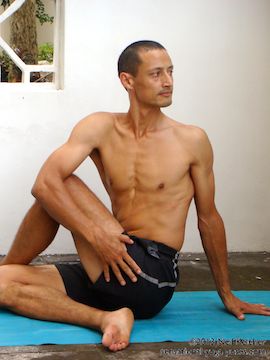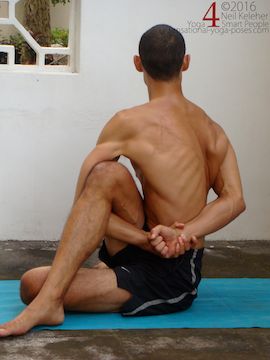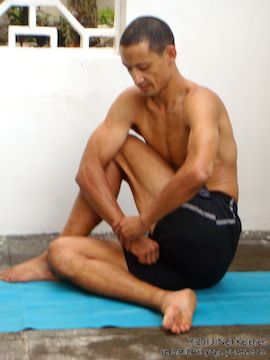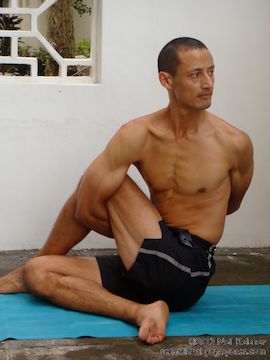(Note that the ankle of the top foot is close to the knee of the other foot.)
If your right leg is on top you can position your left arm to the outside of your right thigh and use if for leverage to help you twist to the right. You could also internally rotate your left arm to reach your left forearm beneath your right thigh and grab your right wrist behind your back.
Note that you twist towards your uppermost leg.

In some versions of this pose, instead of grabbing your hand behind your back you actually grab onto the instep of your right foot with your arm to the outside of your right knee.
However, if you can't grab the foot, another option is to grab the top of the lowest knee instead.
To get into ardha matsyendrasana the first step is to set up your legs.
Setting Up Your Bottom Leg
Ideally both sitting bones are on the floor in this pose. That means that you can't "sit" on your bottom foot. Instead, try to position your bottom foot close to the opposite buttock without it actually being under your buttock.
Setting Up Your Top Leg
Generally in Ardha matsyendrasana the top foot is positioned on the outside of the bottom leg thigh. However, if this is too difficult, modify the foot position. Place your foot to the inside of your shin instead.
Note that you can vary the position of your top foot relative to the bottom thigh. You can position the foot closer to the buttock so that the knee is more closed. Or you can position the foot closer to the knee so that the top knee is more open. If you want to bind in this pose, then you need more space beneath the knee and so positioning the foot closer to the knee is the better option.
If you aren't binding, or if you are playing around with the pose prior to binding, you may find that positioning the top foot closer to the bottom buttock causes the upper thigh to externally rotate to a greater degree.
The point here is to be aware. Notice where you top foot is in relation to your bottom thigh and vary the position if you need to.
Positioning Your Pelvis
Ardha Matsyendrasana is, among other things a twist for the spine. Because the hips are already being stretched due to the position of the legs, you may find it helpful to position your pelvis so that your hips have optimal space. With your pelvis thus positioned, you can then stabilize it so that you then have a foundation for twisting your spine. You can then work at turning your ribcage relative to your pelvis and even turning your ribs relative to each other so that you deepen the twist as you move up your spine.

Ardha Matsyendrasana without Binding
In this pose you twist towards your top leg and because of this you may find that your pelvis tends to turn in the same direction. This may reduce space at the inside of the top leg hip.
If you notice any pinching sensations here, or a sense that you are grinding the inside of the hip socket, work at turning your pelvis in the opposite direction.
So that the top leg hip is active, push your top knee outwards against your arm so that the hip joint has tension.
You can then use that tension to maintain space in your hip joint and to maintain the position of your pelvis even if you go deeper into the twist.
Positioning Your Top Knee
Note, that even if you are pushing your knee outwards against your arm, you can adjust the position of your knee while maintaining the push.
As you vary the amount of twist in your ardha matsyendrasana, you can vary the position of your knee while continuing to push it outwards. Failing that, you can always relax the outwards push of you knee, adjust your knee position, and then resume the push.
Grabbing the Foot
If you want to grab the inside of the foot press your arm back against your knee to level the side of your ribcage forwards.
From there if you can first grab the knee of your bottom foot and then, when you loosen up, you can try grabbing the insole of your top leg foot.
Once you have the foot, use the leverage offered by your arm to try to deepen the twist. But prior to that focus on relaxing. The more you relax the easier it is (depending on the position you are in) to stretch.
Binding
Earlier I suggested that ideally you have both sitting bones on the floor in ardha matsyendrasana. However, if you are in the process of binding you may find it easier to bind if you lift your top-leg hip off of the floor.
So, if you are twisting to the left and your left leg is on top, allow your left hip to lift.
One reason for grabbing the foot before you bind is that you can use the foot to help pull your arm and shoulder downwards. In order to bind you need your elbow to be at or below the crease at the back of the knee.
Once it is here, you can let go of the foot then use your other hand to push your forearm under your leg. You'll probably find that once your hand passes the thigh it is then relatively easy to grab the wrist of your other hand behind your back.
Note that this action, using one hand to push the other under the thigh is the same that is used when doing Bound Twisting Side Angle.
Notice that to push the elbow down, the shoulder also has to go down. And that may mean "sinking" the same side of the ribcage.
Leg Actions In Ardha Matsyendrasana While Binding
Once you bind, you could work at pressing your lifted sitting bone down to the floor. That can be tricky and if you are new to binding it may not be worth the effort. What may be more important is pressing your leg outwards against your arm once you are bound. At the same time push your arm back against your leg.
Shoulder Actions in Ardha Matsyendrasana While Bound
To deepen the twist while bound, work at moving your left shoulder back, relative to your ribcage. If you are familiar with shoulder blade movements, retract your left shoulder blade. Because your arm is more or less immobilized by the bind, trying to retract is more likely to cause your ribcage to move relative to your shoulder blade.
You could help the twist with your opposite shoulder by trying to protract it.
Spinal Activations To Protect Your Spine While Binding
You may be putting a lot of torque on your spine as you do retract your shoulder. So that you keep your spine safe while doing this you can use your abs to try to resist the twist. You could also work at making your spine feel long.
The act of making your spine feel long with help to activate muscles like your spinal erectors and perhaps even your psoas and quadratus lumborum. So you then are not only using your arms, you are using your spinal muscles themselves to help twist your spine.
Focus on "internally rotating" your right shoulder to do this.
Trouble Binding
If you have trouble betting your arm under your leg in ardha matsyendrasana, you may find that penguin shoulder stretch helps.
Published: 2011 04 28







